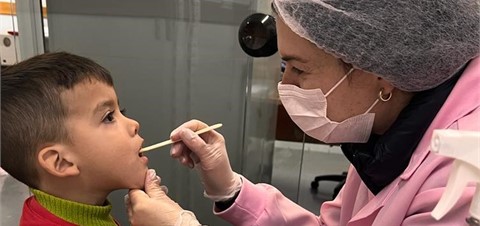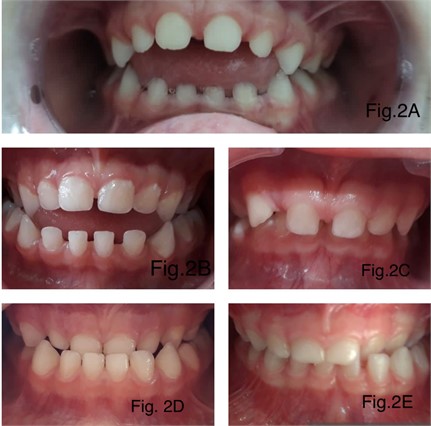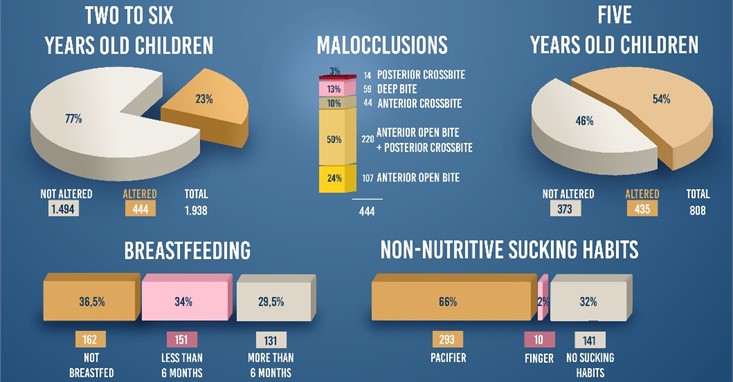Abstract
Knowing that the worldwide prevalence of malocclusion in early childhood is 54 %, we carried out a pilot project in the first half of 2022 at Public Schools in Bento Gonçalves RS, evaluating 1938 children between 2 and 6 years old. The prevalence of malocclusion found was 23 %. Anterior open bite, whether or not accompanied by posterior crossbite, was the most prevalent malocclusion. About 70 % of the children were not breastfed or breastfed for less than 6 months, presenting a non-nutritive sucking habit. Assessing 5 years old children alone, this prevalence rose to 54 %. The results reinforce the need of public health policies that promote and support prolonged breastfeeding, which expand the knowledge of parents or guardians and school staff about the adverse effects caused by the use of pacifiers and baby bottles, with the adoption of transdisciplinary measures for the prevention, interception and treatment of malocclusions in a timely manner.
1. Introduction
Malocclusion is the third largest oral health problem in the world and an important public health issue. The national oral health survey carried out in 2010 identified malocclusion in 67,3 % of children aged 5 years. Breastfeeding is associated with a lower prevalence of malocclusion, having an effect proportional to its duration2. Non-nutritive sucking is another factor that contributes to the increased prevalence of malocclusion in this age group3. In early childhood, the worldwide prevalence of maloclusion is 54 %, remaining uncharged in the permanent dentition4. This pilot project aimed to evaluate the prevalence of malocclusion in children aged 2 to 6 years enrolled in public schools in Bento Gonçalves, RS, and to relate it to the duration of breastfeeding and the presence of non-nutritive sucking. In view of the results, justify the need for integration between Department of Health and Department of Education, in order to promote quality of life, based on the promotion of oral health, prevention and timely intervention in malocclusions.
2. Methodology
2.1. Clinical examination
The epidemiological survey was carried out in the first semester of 2022 by the dentist of the prevention team at public schools of Bento Gonçalves, RS, Brazil. Children between 2 and 6 years old were examined. Examination of the oral cavity was performed through direct visual inspection, using disposable wooden spatulas to push away soft tissues.
Fig. 1Dentist Juliana Schenato during clinical examination in 5 years old student at Educador Paulo Freire Public School. Personal archive. Photo with consent of the child’s parent. May/22

2.2. Classification
The following types of malocclusion were categorized: anterior open bite, posterior crossbite, deep bite, anterior crossbite and anterior open bite alongside posterior crossbite, regardless of severity. Once the data was extracted, the condition of specifically children at 5 years old were analyzed, an age group used in other studies. As soon as the malocclusion was identified, the nursing technician received a data collection form to deliver to the person responsible for the child, with the intention of relating the changes in growth and development found with the time of breastfeeding and deleterious sucking habit (pacifier or finger).
Fig. 2Types of malocclusion classified: 2A (anterior open bite) 2B (anterior open bite alongside posterior crossbite), 2C (deep bite), 2D (anterior crossbite), 2E (posterior crossbite)

3. Results
1938 children were examined. Of these, 23 % (444 children) had some type of malocclusion. Anterior open bite alongside posterior crossbite was the most prevalent type of malocclusion (50 %), followed by anterior open bite (24 %), deep bite (13 %), anterior crossbite (10 %) and posterior crossbite (3 %). Evaluating the duration of breastfeeding in the group of children with malocclusion, were observed that 36.5 % of them did not breastfeed or were breastfed for less than 6 months (34 %). In addition, 66 % use a pacifier and 2 % suck their thumb. Analyzing children aged 5 years (808 children) alone, the prevalence of malocclusion increased to 54 %. The influence of the short period of breastfeeding and the presence of non-nutritive sucking habits on the prevalence of malocclusions was clear.
Fig. 3Graphs representing the sample examined, the alterations found, the alterations in the age group of 5 years, and the duration of breastfeeding and the presence of non-nutritive sucking in children who presented some type of malocclusion

4. Conclusions
Given the high prevalence of malocclusion found in this pilot project (especially at 5 years old children) and the association with a short period of breastfeeding and the presence of non-nutritive sucking habits, it urges the need of public health policies that promote and support the prolonged breastfeeding and expand the knowledge of parents and school staff about the adverse effects caused by the use of pacifiers and baby bottles, with the adoption of transdisciplinary measures for the prevention, interception and treatment of malocclusion in a timely manner.
References
-
“Aprova as diretrizes e normas regulamentadoras de pesquisas envolvendo seres humanos,” Brasil. Ministério Da Saúde. Conselho Nacional De Saúde. Resolução No. 466, 2012.
-
A. Abate, D. Cavagnetto, A. Fama, C. Maspero, and G. Farronato, “Relationship between breastfeeding and malocclusion: a systematic review of the literature,” Nutrients, Vol. 12, No. 12, p. 3688, Nov. 2020, https://doi.org/10.3390/nu12123688
-
H. T. B. Ling et al., “The association between nutritive, non-nutritive sucking habits and primary dental occlusion,” BMC Oral Health, Vol. 18, No. 1, pp. 1–10, Dec. 2018, https://doi.org/10.1186/s12903-018-0610-7
-
G. Lombardo et al., “Worldwide prevalence of malocclusion in the different stages of dentition: A systematic review and meta-analysis,” European Journal of Paediatric Dentistry, Vol. 21, No. 2, pp. 115–123, Jun. 2020, https://doi.org/10.23804/ejpd.2020.21.02.05
About this article
The authors have not disclosed any funding.
The datasets generated during and/or analyzed during the current study are available from the corresponding author on reasonable request.
The authors declare that they have no conflict of interest.
The research met all applicable standards for the ethics of experimentation. According to resolution. Participants provided written informed consent prior to the study.
